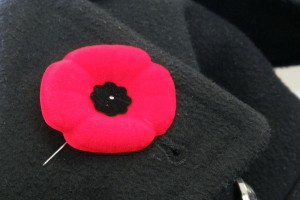Through all the hate, through all the anger, through all the blood spilt on the fields of a foreign land, poppies were born.
Lying dormant and still, they were awoken by thousands of soldiers fighting for the cause, fighting to defend their country.
It wasn’t until after the war was over, and the soldiers dead and gone that the poppies started growing, surrounding the dead and covering the wounds of a murdered mother nature. Few elements of the natural world could survive, but somehow they did.
“It started in the battlefields of France, the earth was very much shook up, there was significant amounts of lime which then tend to generate growth and the poppies spread all over the battlefields,” said Bill Maxwell, secretary of the Poppy and Remembrance Committee for the Royal Canadian Legion in Ottawa.
Stumbled upon by a Canadian soldier, the ornamental flowers were the muse for a poem soon to become a tale in history. The poem spoke of the gentle life forms growing in a field, row by row.
“Since 1921, the poppy has stood as a symbol of remembrance for all Canadians,” he said.
But the poppy’s place in Canadian history started before then.
Moina Michael was an American teacher on duty at the YMCA Overseas War Secretaries’ headquarters in New York.
“Moina Michael was working in a canteen when she started wearing a poppy, in memory of the millions who died in the battlefield,” said Maxwell.
A young soldier brought Michael a copy of the November Ladies home journal, and within those contents she came across the poem ‘We Shall Not Sleep’, later named ‘In Flanders Fields’.
Touched by the story, Michael vowed to wear a poppy to keep the faith and as a sign of remembrance. She became known as ‘The Poppy Lady’.
Because of her dedication to the red poppy many organizations adopted her custom and with the help of the ‘French Poppy Lady’ it became and international custom.
“During a visit to the United States in 1920, a French woman named Madame Anna E Guérin learned of the custom and then she decided to make homemade poppies,” said Maxwell.
Upon her return to France, Guérin was bound to the idea of introducing the custom to countries allied with her own.
On July 5, 1921, the Great War Veteran’s Association of Canada (later becoming the Royal Canadian Legion) adopted the poppy as its symbol of remembrance.
“It’s also an international symbol of collective reminiscence, as in Britain, mainly the common world have adopted the symbol of remembrance and sacrifice,” he said.
For 90 years Canadians have worn the poppy on their lapels and proudly displayed their thanks for the soldiers who died in honour of their country.
“Every year millions of Canadians wear poppies in the memory of the sacrifices made,” said Maxwell.
“Other people use other examples as peace and then they try to say, well this is a symbol of war or whatever, and it is not a symbol of war, Canadians know that, it’s a symbol of the sacrifice made, so that we can enjoy the freedoms that we do enjoy today.”
